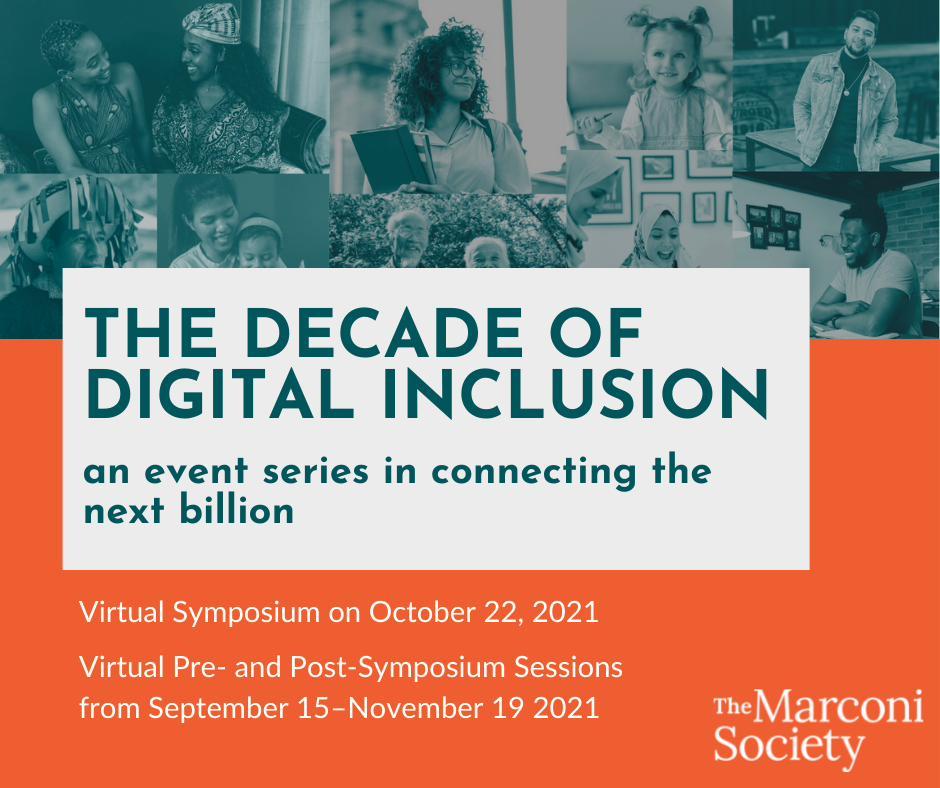Significant contributions to this post were provided by CCC Senior Program Associate, Khari Douglas.
T he Marconi Society, a nonprofit chaired by Vint Cerf and dedicated to bridging the digital divide, held a virtual symposium on Friday, October 22nd, to celebrate the newest Marconi Fellow Andrea Goldsmith.
he Marconi Society, a nonprofit chaired by Vint Cerf and dedicated to bridging the digital divide, held a virtual symposium on Friday, October 22nd, to celebrate the newest Marconi Fellow Andrea Goldsmith.
Friday’s symposium was really a call to action for the computing, and specifically networking, community. The three keynote speakers Doreen Bogdan-Martin (International Telecommunications Union), Jessica Rosenworcel (Federal Communications Commission), and Andrea Goldsmith (Princeton University) all made the case for the urgent, pressing need for expanding access to connectivity.
In her keynote, Bogdan-Martin stated that 3.7 billion people still have no online connectivity, which is about half of the world’s population. In the US, 25% of the population still lacks a home broadband connection. Children in this country have access to the internet at school but not at home. Currently, as Rosenworcel mentioned, 17 million kids are in this so-called “homework gap.” There are two key issues causing this homework gap, 1) some rural and other communities in the country do not have the infrastructure to support broadband, and 2) affordability. Goldsmith brought all of these points together in her address. Yes, the next goal is to connect the next billion, but we need to bridge this digital divide first. We can do this by cellular architectures for long range coverage, satellite systems, and lower cost hardware and software. It is not going to be easy, nor inexpensive, but connecting the next billion is possible Goldsmith believes.
During the “In a World with Unlimited Spectrum” breakout session, which addressed various models to allow consumers, businesses, and governments high quality and affordable connectivity, Jon Peha (Carnegie Mellon University) said that we have technically always lived in a world of unlimited spectrum, but have not always had the technology to access all of the spectrum at a reasonable costs or had a good system for maximizing the spectrum we have access to. He argued that we need policies which “unleash technology innovation and remove barriers,” rather than removing regulators and trying to have engineers or the market solve this problem. Peha called for finding and establishing regulators in this space who are equipped with “rules that evolve over time” and that are “informed and know what they are doing.” Computing researchers who are interested in the policy space should stay alert for such opportunities to influence access to online connectivity when they do arise.
The COVID-19 pandemic has accelerated the prevalence of virtual and hybrid events and activities, most notably in education and the workplace. While in-person events have begun returning, these shifts to virtual and hybrid options will likely remain — at least to some degree — for other reasons, such as the environmental impacts of travel and increased equity in terms of who is able to attend events. It is clear that in order to continue to work and learn, we need to take urgent action to connect the remaining population. The virtual or even hybrid world is not going anywhere anytime soon.
This symposium is part of a series of virtual discussions taking place over the course of two months. The conversions continue next month with a session on Where Network Intelligence Meets Public Policy.
With huge infrastructure investments and consumer subsidies becoming widely available, accurate metrics and insights to identify areas of greatest need will be more critical than ever. While shortcomings of the current data are widely known, alternative crowd-sourced data collection methodologies that are open-source, transparent, accurate, reliable, and scalable are elusive and met with opposition from special interests. This track examines possibilities and solutions from all sides.
- Demystifying the Data – November 16, 11 a.m.–12 p.m. ET
- How Should Data Inform Policy and Funding Priorities? – November 17, 11 a.m.–12 p.m. ET
- Crowdsourcing Network Data at Scale – November 18, 2–3 p.m. ET
See their website to register and learn more.









